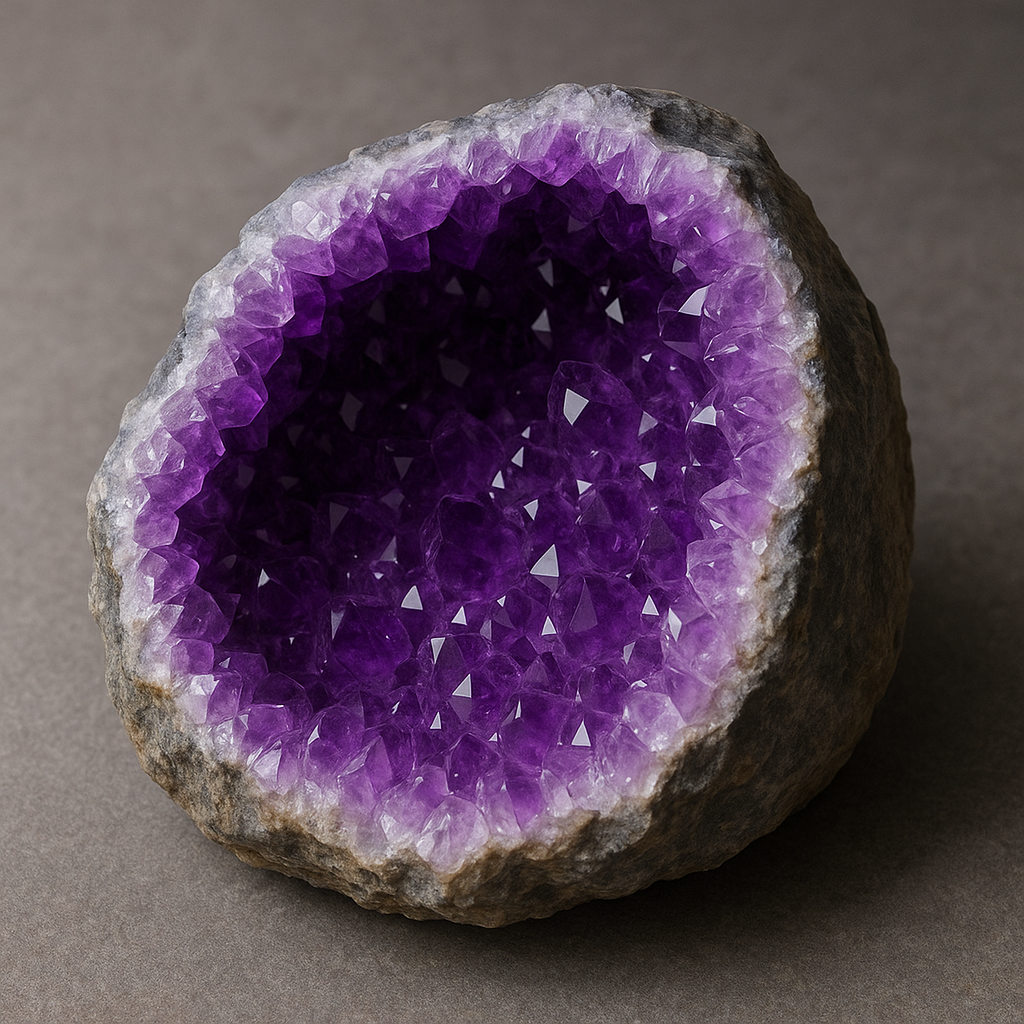
Amethyst History, symbolism and virtues
Share
1. Origin of the name and history
Etymology : The word "amethyst" comes from the ancient Greek "amethystos", literally "not drunk" (a-: privative and methystos: drunk).
Greek mythology : Legend has it that Dionysus, god of wine and intoxication, was pursuing a young woman named Amethyst. To protect her, the goddess Artemis transformed her into a statue of pure quartz. Dionysus, overcome with remorse, poured wine over the statue, which turned it a purple hue. Thus, the stone was born.
Ancient Egypt : Amethyst was used to ward off evil spirits and protect the dead. It was often included in funerary jewelry.
Middle Ages : Considered a symbol of purity and humility, it adorned the rings of bishops. It was also worn by knights for protection in battle.
Renaissance : Alchemists believed it strengthened the intellect and concentration during meditation or study.
2. Main deposits
Amethyst is found on every continent, but some countries stand out for the quality and abundance of their crystals.
- Brazil is now the world's largest producer of amethysts. Deposits located in the state of Rio Grande do Sul offer crystals of all hues, ranging from pale to deep violet, sometimes with blue highlights. Neighboring Uruguay provides amethysts of exceptional quality, with dark, saturated hues that are highly sought after in jewelry.
- In Africa, Zambia stands out for its intense blue-violet crystals, rich in iron and of great purity. Madagascar, meanwhile, is known for its amethysts with softer shades, sometimes pinkish or very clear, which seduce with their natural transparency.
- Russia, particularly the Ural Mountains, has long been an important mining center. Russian stones are renowned for their cool, almost bluish hue and distinctive luster. Active deposits are also found in India, Mexico, Sri Lanka, and Canada, particularly in Ontario, where the crystals can form into large, massive points.
Each of these places brings its unique mineralogical signature, influenced by the geological conditions specific to each region.
3. Chemical composition and structure
Family : Macrocrystalline Quartz
Chemical formula : SiO2 – Silicon dioxide
Crystal system : Trigonal
Hardness (Mohs scale): 7
Cleavage : None
Fracture : Conchoidal
Color : Pale to dark purple. Sometimes tinged with red, blue, or pink.
Origin of the color : Presence of iron (Fe3+) and natural irradiation (gamma radiation).
Luminescence : Sometimes visible under UV – very weak.
Transparency : Transparent to translucent
Luster : Vitreous
4. Physical properties and lithotherapy
Effects on the body
- Soothes muscle tension, especially in the shoulders and neck
- Relieves headaches and migraines
- Promotes deep sleep, fights insomnia
- Strengthens the immune system and metabolism
- Can help with addiction (alcohol, tobacco, etc.)
- Slows down cellular aging (use as an elixir under supervision)
5. Psychic and spiritual properties
- Mental calming: calms intrusive thoughts and inner agitation
- Clarity and concentration: promotes lucidity, memory, creativity
- Protection: absorbs negative energies, wards off harmful influences
- Spiritual development: useful for meditation, intuition, lucid dreams
- Transmutation: transforms negative emotions into positive vibrations
Used by Buddhist monks, alchemists and healers for centuries.

6. Associated Chakras
- Third Eye Chakra (Ajna): Develops intuition, inner vision, clairvoyance.
- Crown Chakra (Sahasrara): Connects to universal wisdom, spirituality, the divine.
It acts as a bridge between the physical world and the spiritual world.
7. Associated astrological signs
Amethyst resonates particularly with certain signs:
- Pisces: accentuates their spirituality and calms their emotions
- Aquarius: balances their very active mind
- Sagittarius: Channels their energy towards elevation
- Also beneficial for: Virgo (serenity), Capricorn (spirituality)
8. Purification and recharging
Purification :
Recommended gentle methods:
- Clear or slightly salted water (avoid direct salt)
- Incense (sage, sandalwood)
- Tibetan singing bowl
- Place on a druse or cluster of quartz
Recharging:
- Moonlight: Ideal full moon
- Quartz cluster or amethyst geode
- Flower of life, wave form
- Earth: for deeper purification/reconnection (24 hours in natural fabric)
Avoid prolonged direct sunlight: the stone fades over time.
9. Symbolism of amethyst
- Spirituality and wisdom
- Purity of the soul
- Protection against illusion and temptation
- Transcendence
- Awakening of consciousness
- It is often called "the stone of the wise and the awakened."
